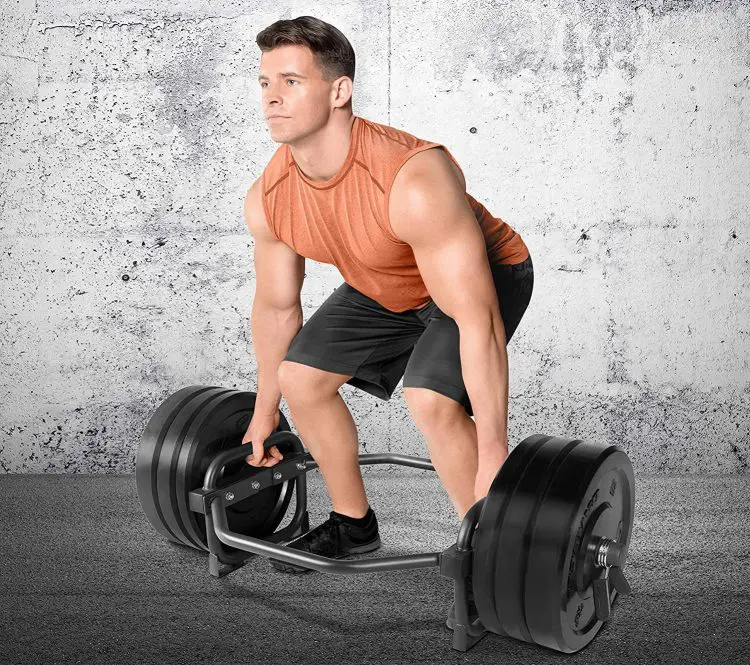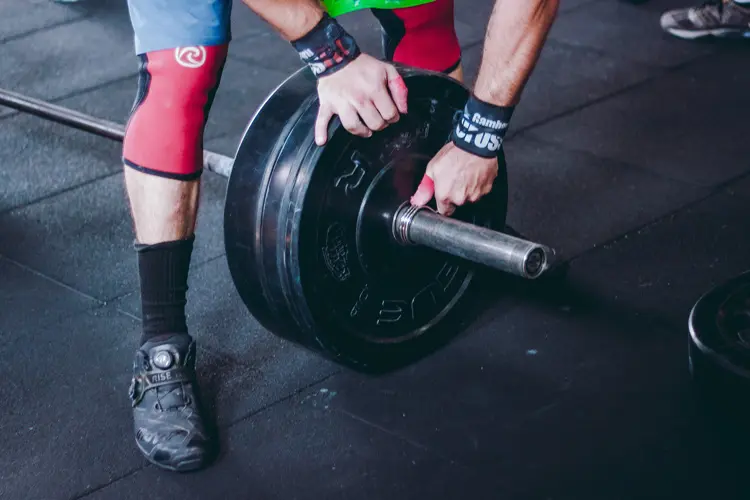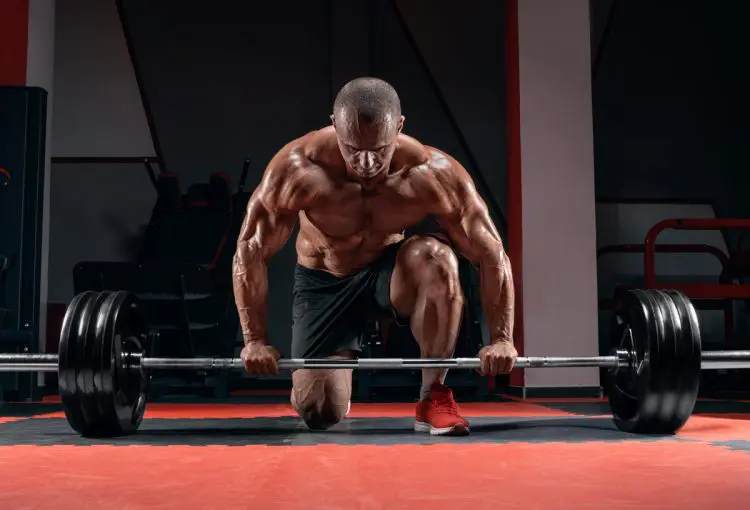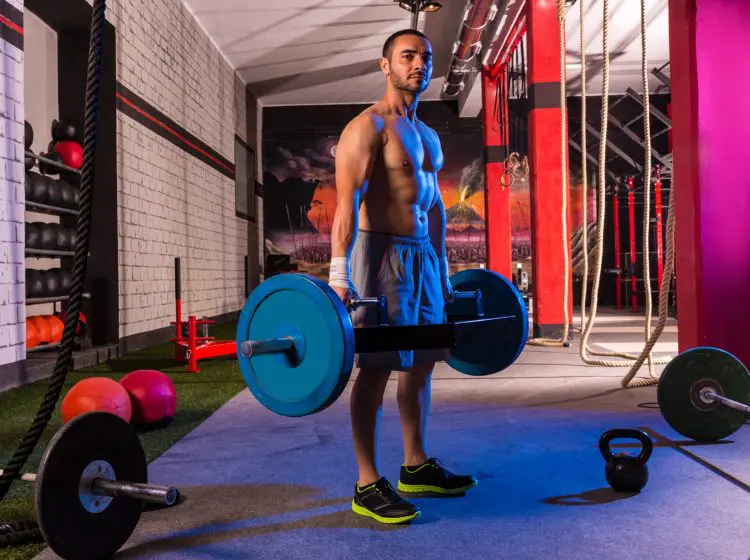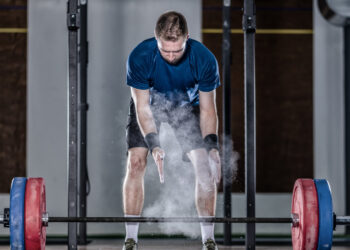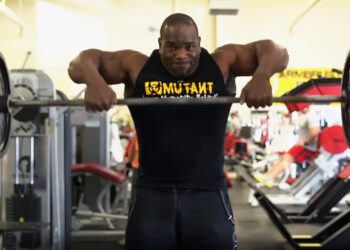Deadlifts are, hands down, one of the best exercises you can do for your posterior chain muscles—the muscles of your upper back, lower back, glutes, hamstrings, and even your calves. With just one simple movement, you work all of these important muscles at once, making it a truly high-quality exercise.
In a way, deadlifts are sort of the “ultimate” test of your back strength. It takes a strong back to perform deadlifts with heavy weight, and requires practice and expertise to master the form in order to avoid injuries.
Typically, deadlifts are done using the standard Olympic barbell. However, there is an argument to be made that using the hexagonal-shaped “Hex Bar” (also called a “Trap Bar”) might actually lead to better performance, reduced injury risk, and greater load capacity. Below, we’re going to dive deep into the subject and analyze the two types of bars to determine how they match up. By the end of this article, you’ll know exactly which bar to use, when, and for what purpose.
The Olympic Barbell Basics

With the Olympic (standard) barbell, it’s simple and straightforward: a single long, heavy bar (typically 44 lbs./20 kg) that allows you to stack weights on both ends.
To perform the deadlift:
- Start with the weight resting on the ground in front of you, loaded up with as many bumper plates as you can safely lift.
- Stand with your feet spread shoulder width apart, spine straight, and knees slightly bent.
- Bend forward and grip the barbell with your hands slightly outside your leg width.
- Drive your hips forward and keep your back flat as you lift the weight. Keep your head in a neutral position with your chin slightly raised and your chest up, as this will maintain a strong spine throughout the movement.
- If you’re working with light weight, control your movement as you lower the barbell back to the ground. If the barbell is fully loaded, it’s okay to drop the bar on the last rep.
It’s an exercise most resistance trainees are familiar with, and it’s a classic for a reason. Deadlifts deliver a targeted workout to your entire posterior chain—from your upper back down to your hamstrings and calves—that will strengthen your back significantly.
Level Up Your Fitness: Join our 💪 strong community in Fitness Volt Newsletter. Get daily inspiration, expert-backed workouts, nutrition tips, the latest in strength sports, and the support you need to reach your goals. Subscribe for free!
Related: Barbell Deadlift.
The Hex Bar/Trap Bar Deadlift
This variation is performed using the Hex Bar (or Trap Bar), a hexagonal-shaped bar that you can load with weight at the ends. Most Hex Bars also contain handles (the “high handles”) that are also utilized for shrugs, which is where the name “Trap Bar” comes from.
Olympic Hex Bars are slightly heavier than standard barbells—they weigh 45 pounds (20.4 kg).
The performance of the exercise is mostly the same:
- Start with the weight resting on the ground, loaded up with as many bumper plates as you can safely lift.
- Stand inside the hex with your feet spread shoulder width apart, spine straight, and knees slightly bent.
- Bend down and grip the Hex Bar by the handles—some have “high handles” that make them suitable for shrugging, or simply “low handles” integrated into the body of the bar.
- Drive your hips forward and keep your back flat as you lift the weight. Keep your head in a neutral position with your chin slightly raised and your chest up, as this will maintain a strong spine throughout the movement.
- If you’re working with light weight, control your movement as you lower the barbell back to the ground. If the barbell is fully loaded, it’s okay to drop the bar on the last rep.
The same general performance, but there are a few differences between the two deadlift variations.
Related: Trap Bar Deadlift Complete Guide.
A Closer Look at the Noticeable Differences
Grip
With the standard barbell deadlift, you’ve got a few different grip choices: the double overhand grip (pretty standard), the mixed grip (more secure for heavier loads), the double overhand hook grip (with your thumb sitting beneath your fingers). For those with wrist mobility limitations, the variety of grips available with a standard barbell allows for some versatility.
With the Hex Bar, however, there aren’t really these options. There are typically one of two types of handles: the high trap bar handles, or the low integrated bar handles. Because of the nature of these handles, your hands will be turned inward (palms facing your legs) for a very natural grip.
You’ll find that your forearm muscles engage more effectively to hold the weight (similar to the way you can Pull-Up more easily with a neutral grip rather than Chin-Ups or regular Pull-Ups), leading to better grip performance throughout. However, versatility is sacrificed when you use the Hex Bar.
Load
Level Up Your Fitness: Join our 💪 strong community in Fitness Volt Newsletter. Get daily inspiration, expert-backed workouts, nutrition tips, the latest in strength sports, and the support you need to reach your goals. Subscribe for free!
With the standard barbell deadlift, the weight is loaded entirely on the front hemisphere of your body. You’re carrying the weight in front of your legs, and it’s traveling up and down in this anterior plane. This encourages better loading on the back, but also makes you more prone to leaning forward slightly as you lift. The destabilization of the uneven load forces you to engage your core muscles to balance—which can be a good thing to strengthen your core, but also increases your risk of injury.
With the Hex Bar, however, the load is centered on your body because the hex bar wraps around you rather than sitting in front of you. This means that you get a much better balanced load, and your core does significantly less work of trying to keep you stable. The result is a greater focus on the muscles you are trying to recruit, and lower injury risk overall.
Power
Because of the distribution of the load, you can generate more power in the target muscles using the Hex Bar deadlift than you can with a standard barbell deadlift. With the standard deadlift, your core muscles have to do a lot of the work of counterbalancing you as you move, which engages them alongside the target muscles. However, when you are properly balanced using the Hex Bar, the focus is entirely on the muscles intended to be engaged in the lifting movement.
Overall, you can generate more power in your deadlifts using the Hex Bar. A 2011 study found that “significantly greater peak force, peak velocity and peak power values were produced during the HBD (Hex Bar Deadlift) compared to during the SBD (Standard Barbell Deadlift)” concluding that “the enhanced mechanical stimulus obtained with the hexagonal barbell suggests that in general the HBD is a more effective exercise than the SBD.”
Stabilization
Because your core muscles have to work harder to keep you balanced, the focus is less on the target muscles. This leads to less power generation (as we saw above), but there’s an argument to be made that by forcing your body to counterbalance the weight, the standard barbell deadlift can potentially lead to all-around better strength than the Hex Bar.
The Hex Bar isolates the muscles, focusing the movement more effectively. However, while muscle isolation is excellent for building raw strength, it doesn’t necessarily translate into more effective movement in real life situations. The added core power and balance developed by the standard barbell deadlift is much more “realistic”—it’s the same power and balance you’ll need when lifting things at home or at work.
Mobility
With the standard barbell, hip mobility is absolutely essential. You need good hip motion to transition through the entire range of the movement. Unfortunately, many people suffer from decreased hip mobility thanks to the amount of time spent sitting every day. Excessive sitting encourages the pelvic and hip muscles to relax, essentially allowing them to weaken over time.
When you deadlift and your hip muscles are tight and the joints don’t have full range of motion, there’s only one other part of your body that can be recruited to help with the lift: your back. Often, people with limited hip mobility will curve their back in order to reach the bar, or at the lowest point of the deadlift. This can increase the risk of lower back strain or sprain—improper form is partly why deadlifts are the cause of so many injuries.
With the longer handles integrated into the Hex Bar, you have to go through a lower range of motion to raise and lower the weight to the ground. This is excellent for those with reduced hip mobility—it allows you to complete the exercise without engaging your lower back to compensate for the lack of flexibility. You don’t have to bend quite as far forward to complete the exercise, decreasing the risk of back strain.
Pros and Cons of Hex Bar Deadlifts
Here are a few more benefits and drawbacks of this exercise—they’re not the MAIN FOCUS of the workout, but they’re something to factor in:
Pros:
- No banging your shins with the barbell as you lower the weight!
- The neutral grip of the trap bars makes the exercise easier on your shoulders, elbows, and wrists.
- The exercise is more quad-focused, leading to better leg power development.
- They’re easy and much safer for beginners new to deadlifting.
Cons:
- They can be tough for shorter trainees. The handles are at a fixed width, potentially making the grip too wide for those with shorter arms.
- Less posterior chain focus. The focus is more on the quads, and less on your glutes, hamstrings, and lower back. You’ll need to supplement your workout with more posterior-chain focused variations (like the standard barbell deadlift).
Pros and Cons of Barbell Deadlifts
Here are a few of the minor pros and cons of using the standard Olympic barbell for deadlifts:
Pros:
- Better targeting of your hamstrings and glutes, as well as your lower back.
- You’ll develop better grip strength because of the less-natural grip position, as well as the grip variations you can use for the lift.
- Hex Bars take up a lot more space, while standard barbells are easier to store—making them a better choice for a home gym or a workout room with limited space.
- You can adjust your grip width according to your body type and arm length, finding the position that feels natural for you.
Cons:
- The greater core stabilization demands mean there is a slightly higher injury risk, and the learning curve is steeper to get it right.
- More strain on your lower back. They can be less-than-ideal for those recovering from lower back injuries.
- Prepare to hit your shins a lot in the beginning!
Read also:
- Barbells vs. Dumbbells: Which is Best?
- Lunges vs. Squats – Which Exercise is Best?
- Rack Pull vs. Deadlift
- The Powerlifting vs Olympic Squats: Which Style Is Better?
- High Bar vs Low Bar Squat Debate
- Bicep Curl vs. Hammer Curl
Conclusion:
While both types of deadlifts are excellent, it’s clear that Hex Bar Deadlifts have a slight edge over the standard Barbell Deadlifts. It’s easier on your grip, allows you to generate more power in your target muscles, reduces back injury risk, and allows for a more natural movement even with limited range of motion. Standard Deadlifts do, however, encourage better posterior chain muscle recruitment, making it better for your lower back, glutes, and hamstrings.
For the most effective workout, you’d do well to incorporate BOTH exercises into your routines. The Hex Bar will be safer, but with the standard Barbell Deadlift, you can target the additional stabilizer muscles that will make you more mobile in real life.
Interested in measuring your progress? Check out our strength standards for Rack Pull, Pull Ups, Snatch, and more.

